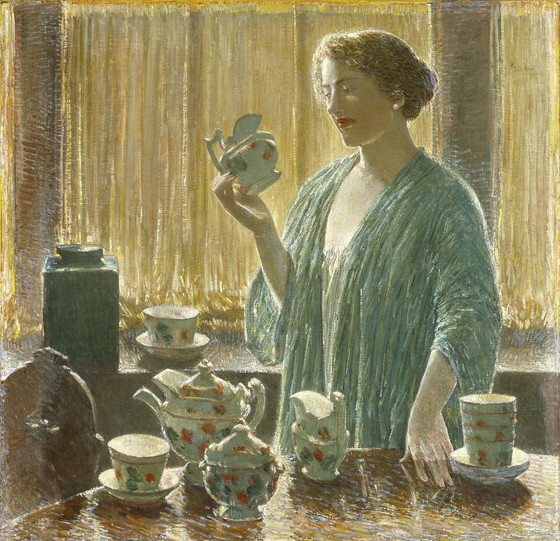Around 1910 Hassam began depicting single female figures set in comfortable domestic interiors....
Around 1910 Hassam began depicting single female figures set in comfortable domestic interiors. The critic Royal Cortissoz referred to these paintings as the "window series," since the figure either sits or stands in front of or next to a window through which sunlight streams into a room. Often the window provides an unobstructed view of the city, but occasionally, as here, a drapery filters the light or even obstructs the view. Usually little of the room is shown, except for a highly polished table, which reflects the sunlight, and upon which is set a delicate vase of fresh flowers, a tea set, platter of fruit, or an objet d’art. The woman is never very active but instead is engrossed in a book, thoughtful contemplation, or quiet examination of an object. Often, as in this painting and Tanagra, 1918 (National Museum of American Art, Smithsonian Institution, Washington, D.C.), the woman is dressed in a loose fitting costume. Tanagra is the window-series painting most closely related to Strawberry Tea Set, sharing the similarity of the woman’s costume, the horizontal composition, and the woman’s fascination with an object that she holds in her hand. In these paintings Hassam came close to the studio productions of the Boston school painters and their depictions of upper-class women living comfortably in their elegant houses. Hassam differed from them in his emphasis on mood, which he conveyed through the figure’s introspective attitude and evocative lighting.
In his delineation of form Hassam was more conservative in the window series than in his flag paintings of the same period. This is especially true of Strawberry Tea Set, where the figure is slightly larger than in most of the other window paintings. Hassam rendered her as quite solid by modeling the form with heavy brushstrokes and manipulating the filtered light. Much less conservative was the palette, as Hassam daringly carried out the composition in a brilliant bluish green, ocher, an electric purple for highlights, and a pure white.
More...



